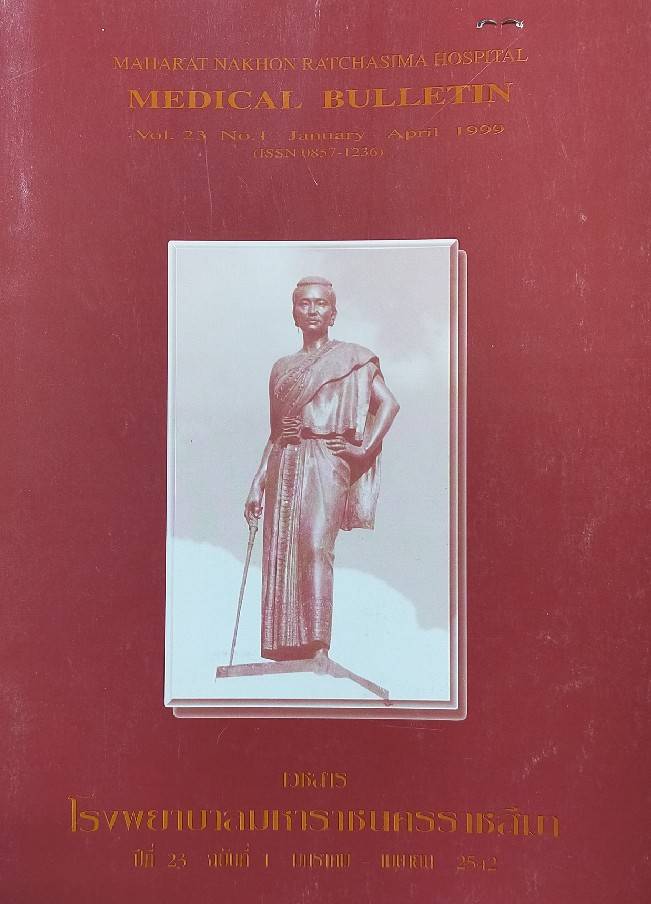Diagnosis of Hirschsprung's Disease
Main Article Content
Abstract
It is rather difficult to diagnose Hischsprung's disease so that delayed diagnosis usually occurs. Objectives. To present diagnostic problems and how to correct them. Methods. This was a retrospective study of patients with Hirschsprung's disease admitted to Maharat Nakhon Ratchasima Hospital during January 1986 to December 1998. The information was collected from hospital and doctor records. Data were analyzed using percentage and ratio. Rerults. There were 173 patients, 141 boys and 32 girls. Information incidence, age, presenting symptoms and diagnosis were completely collected in 121 patients. Ninety eight patients developed symptoms within the first week after birth, 68 patients came to this hospital and only 16 patients were diagnosed as Hirschsprung's disease. Major presening symptoms were abdominal distension and constipation (98 and cases respectively). History of delayed passed meconium was present in 56 cases, while 33 patients could pass normal meconium. Eleven babies needed emergency exploration for clinical signs of necrotizing enterocolitis with peritonitis. Diagnosis was done by present illness, physical examination, plain adominal film and barium enema. We performed barium enema on 108 patients, 23 cases were not diagnosed as Hirschsprung's disease by this study. Overall delayed diagnosis patients was done in 52 cases. There were two main reasons for delayed diagnosis. First, physicians did not think of Hirschsprung's disease in differential diagnosis so that no further investion was performed, and second was incorrect diagnoss by barium enema. These patients came later with chronic and progressive symptoms. Conclusion. Hirschsprung's disease should be diagnosed in neonatal peroid.
Article Details

This work is licensed under a Creative Commons Attribution-NonCommercial-NoDerivatives 4.0 International License.
References
Russell MB, Russell CA, Niebuhr E. An epidemiological study of Hirschsprung's disease and additional anomalies. Acta Paediatr 1994;83:68-71.
Spouge D, Baird PA. Hirschsprung's disease in a large birth cohort. Teratology 1985;32:171-5.
Kiesewetter WB. Rectum and anus. In: Ravitch MM, Welch KG, Benson. CD, Aberdeen E, Randolph JG, editors. Pediatric surgery.3rd ed. Chicago: Year Book Medical Publics, Inc.;1962. p.1059-81.
Alberto P. Imperforate anus and cloacal malformations. In: Ashcraft KW, Holder TM, editors. Pediatric surgery. 2nd ed. Philadelphia: WB Saunders; 1993. p. 372-92.
Swenson O. My early experience with Hirschsprung's disease. J Pediatr Surg 1989;24:839-45.
Swenson O. Early history of the theory of Hirschsprung's disease: facts and personal observations over 50 years. J Pediatr Surg 1996;31:1003-8.
Daniel HT, Arnold GC, Jordan JW, Moritz MZ, Timothy K. Hirschsprung's disease and related neuromuscular disorders of the intestine. In: O' Neil JA Jr., Rowe MI, Grosfeld JL, Fonkalsrud EW, Coran AG, editors. Pediatric surgery. 5th ed. St Louis, Missouri: Mosby Year Book, Inc.; 1998p. 1381-424.
Swenson O, Sherman JQ, Fisher JH. Diagnosis of congenital megacolon: an analysis of 501 patients. J Pediatr Surg 1973;8:587-9.
Helbig D. Hirschsprung's disease in infancy and childhood. In: Holschneider AM, editor. Hirschsprung's disease. New York: Hippokarates Verleg, Stuttgartand Thiema-Stratton; 1982. p. 109-67.
Pooley T Jr, Coran AG, Wesley JR. A ten-year experience with ninety-two cases of Hirschsprung's disease. Including sixty-seven consecutive endorectal pull-through procedures. Ann Surg 1985;202:349-55.
Clark DA. Time of first void and first stool in 500 newborns. Pediatrics 1977;60:457-9.
Klein MD, Coran AG, Drongowski RA, et al. Hirschsprung' disease in the newborn. J Pediatr Surg 1984;19:370-4
Lister J. Hirschsprung: the man and the disease. J Roy Coll Surg Edinb 1977;22:378-9.
Klein MD, Philippart Al. Hirschsprung's disease: three decades experience at a single institution. J Pediatr Surg 1993;28:1291-4.
Taxman TL, Yulish BS, Rothstein FC. How useful is the barium enema in the diagnosis of infantile Hirschsprung's disease? Am J Dis Child 1986;140:881-4.
Rosentfeld NS. Hirschsprung's disease: accuracy of the barium enema examination. Radiology 1984;150:393-5.
Philippart AI. Hirschsprung's disease. In: Ashcraft KW,Holder TM, editors. Pediatric Surgery. 2nd ed. Philadelphia: WB Saunders; 1993. p. 358-71.
Sherman JO, Snyder ME, Weitzman JJ, et al. A 40-year multinational retrospective study of 880 Swenson procedures. J Pediatr Surg 1989;24:833-8.
Smith GH, Cass D. Infantile Hirschsprung's disease is a barium enema useful? Pediatr Surg Int 1991;6:318-23.
Mahaffy SM, Martin LW, Mc Adams AS, et al. Multiple endocrine dysplasia type II B with symptoms suggesting Hirschsprung's disease: a case report. I Pediatr Surg 1990; 25:101-3.
Brenda BS, Danial PR. Surgical evaluation and management of refractory constipation in older children. J Pediatr Surg 1996;31:1040-5.
Loening-Baucke V, Pringle KG, Ekwo EE. Anorectal manometry for the exclusion of Hirschsprung's disease in neonates. J Pediatr Gastroenterol Nutr 1985;4:596-603.
Schuffler MD. A familial neuronal disease presenting as intestinal pseudo-obstruction. Gastroenterology 1978; 75: 889-91.
Tamate S, Shiokawa C, Yamada C, Takeuchi S, Nakahira M, Kadowaki H. Manometric diagnosis of Hirschsprung's disease in the neonatal period. J Pediatr Surg 1984;19:285-9.
Mishalany HG, Wooley MG. Chronic constipation. Manometric patterns and surgical conditions. Arch Surg 1984;119:1257-9.
Mishalany HG, Wooley MG. Postoperative functional and manometric evaluation of patients with Hirschsprung'so sease. J Pediatr Surg 1987;22:443-6.
Meunier P, Marechal JM, Mollard P. Accuracy of the manometric diagnosis of Hirschsprung's disease. J Pediatr Surg1978;13:411-5.
Swenson O, Fisher JH, Gherardi GJ. Rectal biopsy in the diagnosis of Hirschsprung's disease. Surgery 1959;45:690-3.
Dobbins WO, Bill AH. Diagnosis of Hirschsprung's disease excluded by rectal suction biopsy. N Engl J Med 1965; 272: 990-4.
Noblett HR. A rectal suction biopsy tube for use in the diagnosis of Hirschsprung's disease. J Pediar Surg 1969;4:406-9.
Meier-Ruge W. Acetylcholinesterase activity in suction biopsies of the rectum in the diagnosis of Hirschsprung disease. J Pediatr Surg 1972;7:11-5.
Ikawa H, Kim SH, Hendren WH, et al. Acetyicholinesterazerage and manometry in the diagnosis of constipated child. Arch Surg 1986;121:435-8.
Lake BD, Malone MT, Ridson RA. The use of acetycholinesterase (AChE) in the diagnosis of Hirschsprung's disease and intestinal neuronal dysplasia. Pediatr Pathol 1989;9:351-4.
Athow AC, Filipe MI, Drake DP. Problems and adventages of acetylcholinesterase histochemistry of rectal suction biopsies in the diagnosis of Hirschsprung's disease. J Pediat Surg 1990;25:520-6.
Challa VR,Moran JR, Turner CS, et al. Histologic diagnosis of Hirschsprung's disease. The value of concurrent hematoxylin and eosin and cholinesterase staining of rectal biopsies. Am J Clin Pathol 1987;88:324-8.


